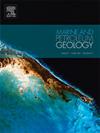Reconstructing hydrocarbon accumulation and burial history of Permian reservoirs in northwest Sichuan Basin, China: Integrated fluid inclusion thermometry and U-Pb dating
IF 3.6
2区 地球科学
Q1 GEOSCIENCES, MULTIDISCIPLINARY
引用次数: 0
Abstract
The western Sichuan basin is a typical foreland basin, and great discovery of oil and gas exploration has been done here, but the history of hydrocarbon accumulation and burial history evolution is still uncertain. Fluid inclusion thermometry and isotopic dating are employed in this study to reconstruct the burial history and hydrocarbon accumulation of the Western Sichuan Foreland Basin. Furthermore, research was conducted research on the diagenesis, reservoir-forming stages and differences of the Qixia Formation reservoirs at different tectonic locations in the northwest of Sichuan. The results show that in the Shuangyushi area (concealed front-edge belt), the upper reservoirs of the Qixia Formation are mainly composed of sparry dolomitic limestone, with a diagenesis mineral sequence of: (1) the early microcrystalline calcite, (2) recrystallized calcite, (3) quartz, albite, pore bitumen in the surrounding rock, and (4) dolomite and calcite in fractures. In the Longmen Mountain piedmont area (thrust nappe belt), the outcrop rock of the Qixia Formation is mainly dolomitic limestone, with a diagenesis mineral sequence: (1) microcrystalline calcite, (2) recrystallized calcite, (3) quartz and bitumen, and (4) calcite filled in both pores and fractures. In the Shuangyushi area, the reservoirs of the Qixia Formation underwent crude oil charging from the Middle Triassic to Middle Jurassic, subsequent natural gas charging in the Late Cretaceous, and final natural gas reservoir destruction and adjustment at Late Cretaceous (81.2 ± 8.4 Ma). While, the outcrop of the Qixia Formation in the Longmen Mountain piedmont area recorded oil charging from the Lower Cambrian source rocks at Late Triassic (217.1 ± 0.9 Ma) and the destruction of oil reservoirs during the Miocene to Pleistocene (i.e., Himalayan orogeny). By comparing the petrological characteristics, fluid inclusion development and reservoir-forming periods of the two areas, it is considered that these disparities arise from the areas’ distinct tectonic positions within the foreland basin, leading to divergent responses to the Indosinian and Himalayan orogeny, as well as the resulting hydrocarbon accumulation processes.
四川盆地西北部二叠系储层油气成藏与埋藏史重建:流体包裹体温度和U-Pb测年
川西盆地是典型的前陆盆地,已取得重大油气勘探发现,但油气成藏史和埋藏史演化仍不确定。采用流体包裹体测温和同位素定年等方法重建川西前陆盆地的埋藏史和油气成藏特征。在此基础上,研究了川西北地区不同构造位置栖霞组的成岩作用、成藏期次及储层差异性。结果表明,双鱼石地区(隐伏前缘带)祁下组上储层主要由亮晶白云质灰岩组成,成岩矿物序列为:(1)早期微晶方解石,(2)重晶方解石,(3)围岩中的石英、钠长石、孔隙沥青,(4)裂缝中的白云石和方解石。龙门山前山带(逆冲推覆带)祁霞组露头岩主要为白云质灰岩,成岩矿物序列为:(1)微晶方解石,(2)重晶方解石,(3)石英和沥青,(4)孔缝充填的方解石。双鱼石地区栖霞组储层经历了中三叠统—中侏罗世原油充注、晚白垩世天然气充注、晚白垩世(81.2±8.4 Ma)天然气储层最终的破坏与调整。龙门山前地区栖霞组露头记录了晚三叠世(217.1±0.9 Ma)下寒武统烃源岩充注原油和中新世—更新世(即喜马拉雅造山运动)对油藏的破坏。通过对比两区岩石学特征、流体包裹体发育和成藏时期,认为这些差异是由于两区在前陆盆地内构造位置不同,对印支和喜马拉雅造山运动的响应不同,对油气成藏过程的响应也不同。
本文章由计算机程序翻译,如有差异,请以英文原文为准。
求助全文
约1分钟内获得全文
求助全文
来源期刊

Marine and Petroleum Geology
地学-地球科学综合
CiteScore
8.80
自引率
14.30%
发文量
475
审稿时长
63 days
期刊介绍:
Marine and Petroleum Geology is the pre-eminent international forum for the exchange of multidisciplinary concepts, interpretations and techniques for all concerned with marine and petroleum geology in industry, government and academia. Rapid bimonthly publication allows early communications of papers or short communications to the geoscience community.
Marine and Petroleum Geology is essential reading for geologists, geophysicists and explorationists in industry, government and academia working in the following areas: marine geology; basin analysis and evaluation; organic geochemistry; reserve/resource estimation; seismic stratigraphy; thermal models of basic evolution; sedimentary geology; continental margins; geophysical interpretation; structural geology/tectonics; formation evaluation techniques; well logging.
 求助内容:
求助内容: 应助结果提醒方式:
应助结果提醒方式:


